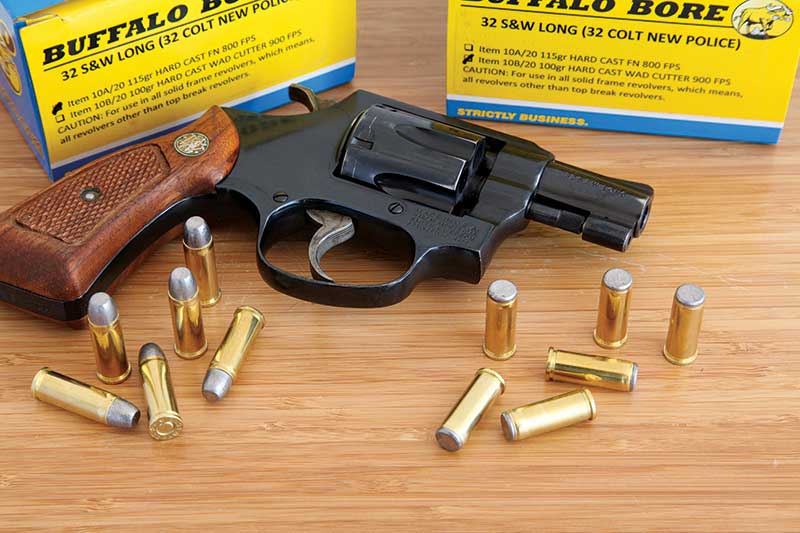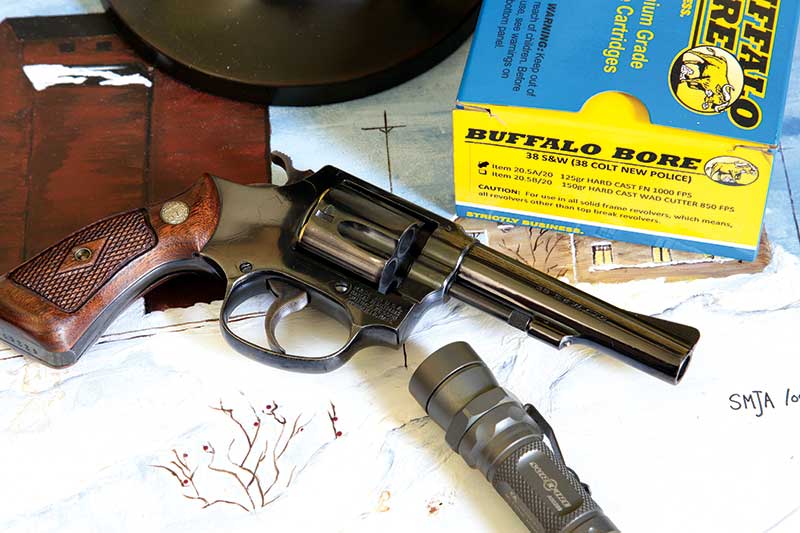The .32 S&W Long & .38 S&W

This S&W Model 30 in .32 S&W Long was made around 1970 on the J-frame.
Why a .32 when the .38 Special version is the same size? Some people wanted less recoil,
plus the .32 cylinder holds six cartridges, the .38 holds five. Buffalo Bore offers two hardcast
lead bullet loads to help get the most out of these old guns.
Some time ago I acquired a handgun I’d rather not have. Barrie Gwillim, a shooting buddy and close friend, died one fall and left me a couple of handguns. The revolver is a S&W Regulation Police in .38 S&W made in 1956 or 1957, on the “Improved I-frame.” The I-frame had a cylinder nominally 1.25″ long and corresponding frame window. Production of I-frames continued during the ’50s, with revolvers chambered for .32 S&W Long, .38 S&W and the popular “Kit Guns” in .22 LR. In 1960-61, S&W dropped the I-frame in favor of the J-frame, which could chamber the longer .38 Special.
Coincidentally about the time I acquired the Regulation Police, shooting buddy Steve Kukowski bought a Model 30, made around 1970. It’s built on the J-frame with a 6-shot cylinder and chambered for the .32 S&W Long. It came from the collection of a long-time friend, Al Francis. Al tried to join the US Navy after Pearl Harbor. He was told the Navy just couldn’t overlook one small problem — Al had been born with only one arm. What the Navy couldn’t overlook the merchant marine could. During the war his ship hauled the vital materials (“beans, boots and bullets”) to keep the armed forces supplied.
I went into the background of how these revolvers were acquired because they represent a current trend. A lot of quality guns from the post-WWII era seem to be coming on the market, some from collections, others found stored away in a dresser drawer.
Early Guns
Before the .38 Special became ubiquitous, the moderately powered .32 S&W Long and .38 S&W were popular. Colt, reluctant to stamp the name of their primary competitor on their revolvers, called these cartridges the .32 and .38 Colt New Police. Many thousands of quality Colt and S&W revolvers were chambered for these cartridges. But, in the early 20th century many inexpensive break-top revolvers were also chambered for these cartridges. In old mail-order catalogs they were advertised for around $3 to $4. The “steel” was little more than soft iron, not heat treated, and they had delicate lock-work components. Most you find today don’t function.
With so many old and weak revolvers floating around, factory loads in .32 and .38 S&W are modest. Currently the Winchester website lists .32 S&W Long with a 98-gr. LRN bullet at 705 fps. The .38 S&W load is a 145-gr. LRN at 685 fps (both from 4″ barrels). Both are pleasant, low-recoil loads, fun for plinking, not to mention a good source of quality brass for reloading. As a defensive load, a LRN bullet at modest velocity is about as bad as it gets. I wouldn’t shoot a skunk in a trap with such loads, much less count on them for defense.
The .32 Long enjoys some popularity as a target round — Federal offers a 98-gr. WC load at 780 fps. Though not intended as a defensive load, it’s wadcutter profile would at least cut a hole rather than just push through. I’m not sold on the .32 Long as a defensive round but I’d use Federal’s WC load to shoot a skunk in a trap — from a good safe distance!
New Tech
Buffalo Bore has developed loads for the .32 and .38 S&W to increase their defensive capability. They use hardcast lead bullets with flat profiles specifically designed not to deform on impact, but to cut and penetrate. Buffalo Bore feels an expanding bullet for these cartridges would be a mistake, as expansion would limit penetration. Hard lead bullets produce higher velocity than jacketed bullets, all else being equal. Buffalo Bore uses what they call “modern powders” to provide higher velocities than other factory loads.
It should be noted these are not “+P” loads. Pressures do not exceed standard SAAMI limits. Buffalo Bore rates them as safe to shoot in any solid-frame (i.e., not top-break) revolver, assuming, of course, it is in safe firing condition.
‘
The chart shows chronographed velocities. The .38 S&W/125-gr. load interests me most, as in my 4″ S&W velocities are similar to what most 125-gr. .38 Special loads produce in 2″ barrels, around 956 fps. The Buffalo Bore 115 .32 S&W Long yielded about 771 from a S&W 2″ barrel, while the 100-gr. WC delivered 852 fps. from the same gun.
With all loads tested recoil was moderate. Accuracy is limited more by short-sight radius than by ammunition, but I could keep most shots in the A-zone of a USPSA target at 25 yards. I’m not sold on anything under .38 Special/9mm Luger for personal defense, but if a .32 or .38 S&W is what you have, these Buffalo Bore loads are a good option. Just not in those cheap top-breaks!
For more info: www.buffalo-bore, (406) 745-2666

Get More Revolver Content Every Week!
Sign up for the Wheelgun Wednesday newsletter here:





